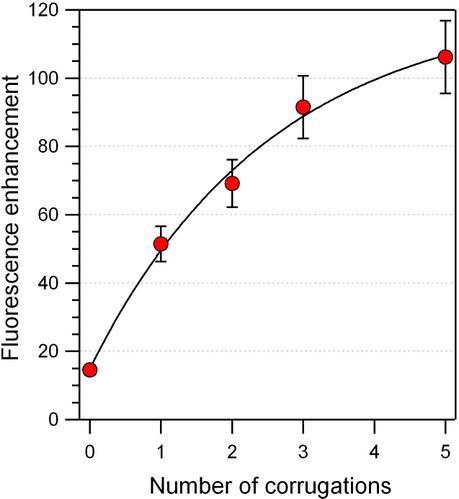Surface-enhanced fluorescence with corrugated nanoapertures
Subwavelength apertures milled in metallic films are receiving a growing interest to tailor light at the nanoscale, and improve the detection methods of single molecules.
In an article published in the July 04th issue of Optics Express, we quantify the influence of the number of circular corrugations surrounding a central nanoaperture to further enhance the fluorescence emission per molecule. This work has three aspects of general interest:
1) We quantify both the excitation and emission gains contributing to the fluorescence enhancement, providing the first complete characterization of corrugated apertures as the number of corrugations is increased.
2) We demonstrate efficient single molecule detection with fluorescence rates clearly above 10,000 counts/second with a simple low NA lens.
3) We show that a single groove milled around a nanoaperture already provides a supplementary 3.5 fold increase in the fluorescence enhancement as compared to a bare nanoaperture. This constitutes the first experimental observation of the effect numerically predicted in Bonod et al, Optics Express 16, 2276-2287 (2008).


OMNT nanophotonic articles selection
Below are a few articles that I recently selected for the OMNT.
“Video-Rate Molecular Imaging in Vivo with Stimulated Raman Scattering” ; Brian G. Saar,
Christian W. Freudiger, Jay Reichman, C. Michael Stanley, Gary R. Holtom, X. Sunney Xie, Science 330, 1368 (2010).
“Imaging Individual Proteins and Nanodomains on Intact Cell Membranes with a Probe-Based Optical Antenna”, Thomas S. van Zanten, Maria J. Lopez-Bosque, and Maria F. Garcia-Parajo, Small 6, 270-275 (2010).
“Plasmon nano-optical tweezers” ; Mathieu Juan, Maurizio Righini, Romain Quidant, Nature Photonics 5, 349 (2011).
Remember that the different OMNT publications are freely available to any researcher working in a CNRS or CEA connected laboratory (UMR, UPR...).

Optical antennas special journal issue
The international journal of optics features a special issue focusing on optical antennas. Read the call for papers here. According to the lead guest editor, already twelve articles are scheduled from major research groups. Deadline for papers 1st september.

Summer School on Plasmonics Porquerolles SSOP 2
The deadline is approaching: before May 30th. Don't miss this opportunity!
Key arguments for your supervisor: excellent quality of invited lecturers + excellent value for the money, the registration fees cover all accomodation & food living expenses.
Make sure to check the SSOP2 official website.


Latest article : fluorescence directional sorting with antennas
Despite intense recent research on optical antennas, tuning the directionality of fluorescence emission remains an open challenge for emitters with random positions and orientations. We address this issue in a recent Nano Letters report, and propose a class of optical antennas to control the fluorescence emission directivity for molecules in solution.
Following on our previous article “Bright Unidirectional Fluorescence Emission of Molecules in a Nanoaperture with Plasmonic Corrugations” by H. Aouani et al (Nano Lett. 2011, 11, 637–644), new scientific findings are now described and analyzed:
1) We describe new design paths for plasmonic antennas to tune the emission directivity based on physical optics interference concepts. This manuscript provides the first complete characterization of the interference phenomenon leading to fluorescence beaming, both experimentally and theoretically.
2) The key result is that for each emission wavelength the fluorescence beam can be directed along a specific direction with a given angular width. For the first time, we demonstrate directional photon sorting between emission beams of spectrally different molecules.




